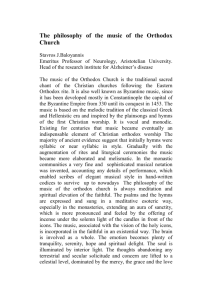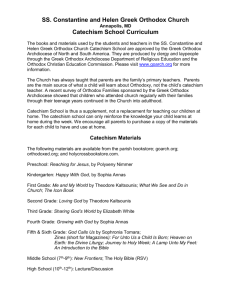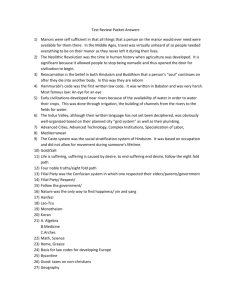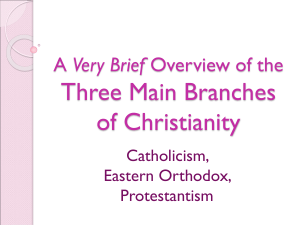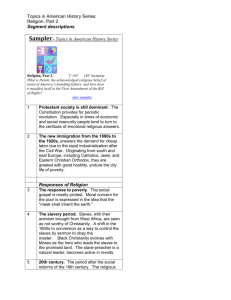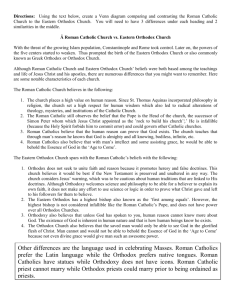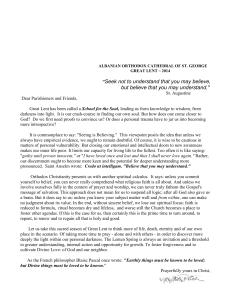Orthodox churches B
advertisement
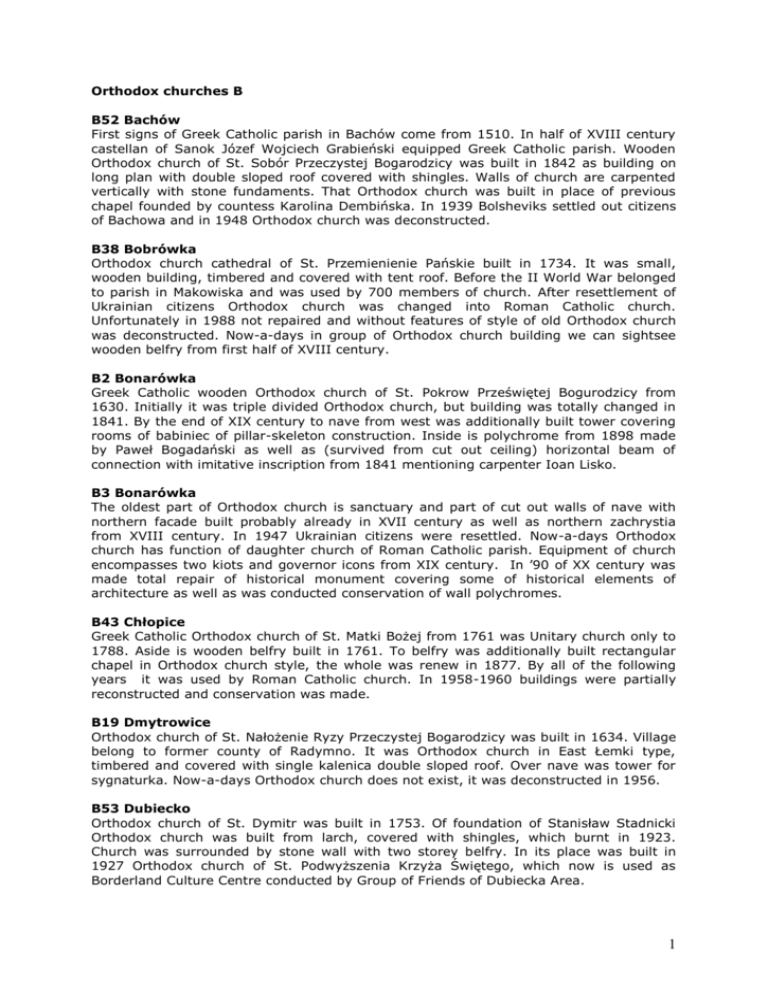
Orthodox churches B B52 Bachów First signs of Greek Catholic parish in Bachów come from 1510. In half of XVIII century castellan of Sanok Józef Wojciech Grabieński equipped Greek Catholic parish. Wooden Orthodox church of St. Sobór Przeczystej Bogarodzicy was built in 1842 as building on long plan with double sloped roof covered with shingles. Walls of church are carpented vertically with stone fundaments. That Orthodox church was built in place of previous chapel founded by countess Karolina Dembińska. In 1939 Bolsheviks settled out citizens of Bachowa and in 1948 Orthodox church was deconstructed. B38 Bobrówka Orthodox church cathedral of St. Przemienienie Pańskie built in 1734. It was small, wooden building, timbered and covered with tent roof. Before the II World War belonged to parish in Makowiska and was used by 700 members of church. After resettlement of Ukrainian citizens Orthodox church was changed into Roman Catholic church. Unfortunately in 1988 not repaired and without features of style of old Orthodox church was deconstructed. Now-a-days in group of Orthodox church building we can sightsee wooden belfry from first half of XVIII century. B2 Bonarówka Greek Catholic wooden Orthodox church of St. Pokrow Przeświętej Bogurodzicy from 1630. Initially it was triple divided Orthodox church, but building was totally changed in 1841. By the end of XIX century to nave from west was additionally built tower covering rooms of babiniec of pillar-skeleton construction. Inside is polychrome from 1898 made by Paweł Bogadański as well as (survived from cut out ceiling) horizontal beam of connection with imitative inscription from 1841 mentioning carpenter Ioan Lisko. B3 Bonarówka The oldest part of Orthodox church is sanctuary and part of cut out walls of nave with northern facade built probably already in XVII century as well as northern zachrystia from XVIII century. In 1947 Ukrainian citizens were resettled. Now-a-days Orthodox church has function of daughter church of Roman Catholic parish. Equipment of church encompasses two kiots and governor icons from XIX century. In ’90 of XX century was made total repair of historical monument covering some of historical elements of architecture as well as was conducted conservation of wall polychromes. B43 Chłopice Greek Catholic Orthodox church of St. Matki Bożej from 1761 was Unitary church only to 1788. Aside is wooden belfry built in 1761. To belfry was additionally built rectangular chapel in Orthodox church style, the whole was renew in 1877. By all of the following years it was used by Roman Catholic church. In 1958-1960 buildings were partially reconstructed and conservation was made. B19 Dmytrowice Orthodox church of St. Nałożenie Ryzy Przeczystej Bogarodzicy was built in 1634. Village belong to former county of Radymno. It was Orthodox church in East Łemki type, timbered and covered with single kalenica double sloped roof. Over nave was tower for sygnaturka. Now-a-days Orthodox church does not exist, it was deconstructed in 1956. B53 Dubiecko Orthodox church of St. Dymitr was built in 1753. Of foundation of Stanisław Stadnicki Orthodox church was built from larch, covered with shingles, which burnt in 1923. Church was surrounded by stone wall with two storey belfry. In its place was built in 1927 Orthodox church of St. Podwyższenia Krzyża Świętego, which now is used as Borderland Culture Centre conducted by Group of Friends of Dubiecka Area. 1 B59-61-61-68 Dusowce Orthodox church of St. Przemienienie Pańskie built in 1641, in following joint to parish in Krzeczowice. Constructor of the first wooden Orthodox church was Iwan Szczerabtyj from Hussakowa. Church on long plan, clearly triple divided, in whole covered with shingles. Four sphere roof, over nave dome with small tower for sygnaturka. Building surrounded with side roofs. In post war times Orthodox church was ruined and now-a-days does not exist. B46-47-48 Garbary Orthodox church of St. Onafry does not exist any more. Village was included to Jarosław, now-a-days became a suburb and called Garbacze. In place of old Orthodox church citizens of suburb are building chapel. B6 Grzęska Greek Catholic Orthodox church of St. Pokrow Przenajświętszej Bogarodzicy is a wooden building of stoner fundaments. Double divided construction on long plan with presbytery and nave. Initially window spaces were situated only on north side of nave and presbytery. Double sloped rood covered with shingles with seeming belfry in centre. Now-a-days is used by Roman Catholic church. B86 Izdebki Orthodox church of St. Wniebowzięcie Najświętszej Marii Panny built in Izdebki in 1660. Before II World War in part of village lived Greek Catholics. Orthodox church was building in West Łemki style with double sloped roof, single kalenica. Each parts of church were the same height. It was destroyed after end on II World War. In place of old Orthodox church is situated wooden cross. Painted on board miracle painting of Izdebska God’s Mother from 1720, now-a-days there is situated Roman Catholic church. B85 Jabłonica Polska Survived old Greek Catholic Orthodox church of St. śś. Kosma and Damian built in 1761. Bricked with stones, plastered, surrounded with stone wall. Since 1946 Orthodox church is used by Roman Catholic church. Repaired and renew is in very good shape. B84 Jabłonica Ruska View of church from presbytery side, which was octagonal shape, met in previous buildings. Traditional triple division of Łemki Orthodox church depicted with seem belfry in centre of roof. B75 Jabłonica Ruska Greek Catholic Orthodox church of St. śś. Kosma andf Damian built in 1691. n 1947 was destroyed. B4 Kończyn – first half of XVII centrury The oldest relict of bricked buildings of Orthodox churches comes from XII century. Orthodox church of St. Pokrow Przeczystej Bogarodzicy was built in 1740. Building on Greek cross plan with higher than nave presbytery and entrance in front of babiniec. Double sloped roof, in central part belfry covered with onion dome. After II World War Orthodox church through 37 years was closed without care. In spite of that survived in very well shape. Now-a-days Orthodox church serves as church, repairs and conservation are conducted in it. B42 Korzenica Orthodox church of St. Narodzenie Przenajświętszej Bogarodzicy was built in 1649. It was wooden building, timbered, triple divided. Babiniec was covered with low, double sloped roof, over nave and presbytery were situated typical domes covered with tent roofs. Orthodox church had shady soboty – covered arcades, which during raining were used for processions. 2 B40 Korzenica According to local tradition Orthodox church existed there since XV century and in 1641 citizens of village hid in it against Tartar. Orthodox church was deconstructed in ’50 and in its place was built by the end of ’70 bricked church, modeled into architecture of old church. B54 Kruhel Wielki Wooden Greek Catholic Orthodox church of St. Wniebowstąpienie Pańskie from 1630. Each parts were built on square plan, nave is the widest and in over babiniec and presbytery. In XVIII century was built not attached wooden belfry of Orthodox church, it was reconstructed in 1884, although reconstruction did not changed archaic form of church, which is until present one of the most valuable historical monuments of wooden architecture of Orthodox churches on area of country. After war activities Orthodox church fall into ruin and in 1989 was deconstructed. Building was once again built and reconstructed in 1997-2000. B7 Krzeczowice Greek Catholic parish Orthodox church of St. śś. Mikołaj was built as Roman Catholic church. In 1794, a few years after construction was changed into Orthodox church. Build of fundaments of broken stones, built of cut out construction, timbered with boards vertically with slating. In 1945 Orthodox church was adapted for Roman Catholic church. In 1985 there were conducted general repair works. Since construction in Krzeczowice a new church, Orthodox church was left and was in danger of destroy. In last years it functions as burial house of church. B83 Krzywe Greek Catholic Orthodox church of St. Zaśnięcie Matki Bożej was built in 1759 on hill between trees. It’s a wooden church, outside timbered with boards with slating and ledge arcade, lower belt of boards. With slating and list features of style. To square presbytery and wide rectangular nave was additionally built entrance and sixth side small tower for sygnaturka. Double sloped roof, initially covered with shingles, at the beginning of XX century changed into tin. Since 1971 Orthodox church is used as Roman Catholic church. B18 Leżachów Group of Greek Catholic Orthodox churches of St. św. Nikita from 1796. Wooden church built by carpenter Szymon Dzióbek. B11/31 Leżachów Roof of Orthodox church has cut out shape of fourth space dome, over nave dome double broken. Covered with smooth barrel helmet with so called belfry. Board cut out laid vertically and horizontally. Each cut out board is joint with cup. B37 Leżachów Zachrystia and chapel appeared by Orthodox churches in last decade of XVIII century. Walls of zachrystia ale always lower than presbytery walls. In 1884 by Orthodox church of St. Nikita was additionally built kruchta. Orthodox church was repaired in 1915, 1935 and 1970 and triple division of building was not changed. Now-a-days is used as church. B1 Lubienia Wooden belfry, remaining after first wooden Unitary Orthodox churches, which were situated on hill of village. First from 1790 burnt, the second one was destroyed in 1821. In place of wooden churches in following years were built bricked Orthodox churches on Greek cross plan (1843 and 1895). Now-a-days in this place is situated Orthodox church built in 1893-1895 according to project of architect Wiktor Sygnow. B89 Łodzina 3 Greek Catholic Orthodox church of St. Narodzenie Bogarodzicy built in 1743, one of the oldest in Poland is an example of second architecture spread across XVIII century on area of upper Nadsanie. Church was repaired in 1875, from that time survived complete iconostas. Now-a-days is used as Roman Catholic church. B92 Łodzina View of Orthodox church of St. Narodzenie Bogarodzicy from presbytery side. Roofs and walls are made of shingles, which was get from forested mountain areas did not made any problems. Shingles to the end of XIX century were almost exclusively coverage of Orthodox church. Next to Orthodox church is beautiful old oak. B39 Manasterz Since 1489 existed on slopes of mountain monastery of Greek Catholic church, remains of it is przesiółek in Manasterz. Orthodox church of St. Opieki Matki Bożej built in 1678, it was wooden church, triple divided, covered with double sloped roof. In central part over nave tower with small dome. Orthodox church was burnt in 1950. Now-a-days could be found only remaining of fence of Orthodox church and bricked belfry from 1920. B60 Medyka Orthodox church of St. Bazyl Wielki built in 1737. Wooden building on long plan. Repaired in 1939, 1967 and 1971. In front of Orthodox church is bricked fourth arched belfry. Now-a-days is Roman Catholic church. B45 Miękisz Nowy In 1753 was founded in Miękisz Nowy Greek Catholic parish Orthodox church of St. Świętej Trójcy which was built in 1809. Wooden building on long plan. Over centrally situated nave was dome covered with shingles. In post war times Orthodox church was deconstructed. Now-a-days is only cemetery existing with survived tombs. B15 Miękisz Stary Greek Catholic Orthodox church of St. Pokrow Przeświętej Bogarodzicy was building with clearly stylish coverage. The oldest part is cut out of walls of presbytery – probably from XVII century. In past centuries were made changes – additionally built nave and babiniec, was made so coverage of nave and shape of church was enriched with zachrystia and kruchta. Building is one of not many examples of Orthodox church architecture inspired with bricked Baroque sacral buildings. B20 Miękisz Stary (B32) It’s a wooden building, not too big and uniquely charming. Single nave church, timbered with rectangular windows ornamented with interesting eaves. Roof of nave was covered with cut out, octagonal dome, covered with tent roof with sygnaturka. Toughness in dating makes signs of reconstruction in 1803 – 1811. Greek Catholic Orthodox church of St. Przenajświętsza Boagrodzica was already reconstructed before war in 1925. Unfortunately now-a-days is in poor condition and is becoming a ruin. B8 Mirocin Orthodox church of St. Przemienienie Pańskie built in 1790-1797. Situated on hill, surrounded with fence of stone fundaments hidden in surrounding of trees. To Orthodox church only led one entrance from west side, Orthodox church was always built as presbytery was directed to east. By the Orthodox church was XVIII century belfry. B9 Mirocin View of Orthodox church in Mirocin from presbytery side. Now-a-days does not exist anymore. B41 Mołodycz 4 Building of Orthodox church exists in Mołodycze since 1716. Greek Catholic Orthodox church of St. Narodzenie Najświętszej Bogarodzicy was built thanks to foundation of Mikołaj from Granów Sieniawski. Buildings of Orthodox church were completely repaired in 1969-1971 and unfortunately had completely lost its historical character. Now-a-days functions as church. B14-25 Nielepkowice Orthodox church of St. Jan Apostoł built in 1738 was a big building without towers in Łemki style. The widest and the highest part was nave covered with dome roof. Other parts of triple divided church were covered with double sloped roof. B24 Nielepkowice Traditional triple divided Orthodox church enriched with additional not too big room – in picture could be seen vestibule in front of entrance to babiniec. B26 Nielepkowice To emphasize triple division of shape were used towers on coverage of roof. There were so called belfries ended with small dome of Baroque shape. In XVIII century was created classical type of Łemki Orthodox churches with characteristic octagonal helmet. B74 Nowosiółki Dydyńskie The first wooden Orthodox church was already stated in 1732., probably the following one was built in 1744-1775. Orthodox church of St. Przemienienie Pańskie was built in 1846. Wooden building with double sloped rood covered with shingles, over nave tower for sygnaturka with belfry. Aside Orthodox church was situated belfry built in modern times together with Orthodox church. Church was destroyed while war activities, was rebuilt in ’70 and has function of church. Orthodox church cemetery surrounded with wall from XVIII century. B82 Obarym Daughter Greek Catholic Orthodox church of St. Przemienienie Pańskie was built in 1828 of initiative of Tekla Bogdańska-Poberocka. It’s a wooden church of cut out construction of long octagonal plan. In past with indicated triple division. Orthodox church was covered with barrel dome. B81 Obarym In inside of Orthodox church survived wooden epitaph with inscriptions of Tekla of Bogdańska-Pohorecka form 1846 and Ludwik Wysocki from 1848. Unfortunately illusionist polychrome with architecture light motive form XIX century was destroyed. B76 Obarym Orthodox church was twice renew – in 1929 and 1970. With partial loss of style features. It was than changed kalenica coverage, eight spaced roof and polychromes were timbered. In 1970 Orthodox church was changed into Roman Catholic church, dome was than changed into small tower. B72 Pacław Wooden Orthodox church below hill in nearby of Pacław was built previously, in 1900 was built bricked chapel. It was wooden church, double divided, on long plan, surrounded with sobota, which during fall of rain was used for processions. After war was destroyed. B73 Pacław Next to Catholic Kalwaria Pacławska existed also Kalwaria for Greek Catholics – wooden chapel of Saint Heart built in 1932 as well as bricked chapel from 1936. Now-a-days Orthodox church buildings does not exist anymore. B68 Piątkowa 5 Wooden Greek Catholic Orthodox church of St. św. Dymitr from 1732 considered as one of the most beautiful in Podkapacie area. It’s a wooden, cut out, triple divided building. Over centrally situated nave was situated the biggest eight sphere dome, over other parts of Orthodox church were also situated smaller domes – features of style supported with bricked pillars. In 1958-1961 was renew with efforts of State Conservatory of Historical Monuments. Now-a-days building belongs to Museum of Folk Buildings in Sanok. B16 Piskorowice Orthodox church was built in 1842, its found by Maria and Alfred Potoccy. Orthodox church belonged to so called Józefińska Orthodox churches, based on Austrian patterns. Bricked on long plan with tower over babiniec. B17 Piskorowice Orthodox church of St. Jan Apostoł was built in 1842 as church on long plan. After resettlement of citizens in post war times Orthodox church was deconstructed. Now-adays only ruins and stone fundaments are left. In place of old Orthodox church was places historical cross. B69 Posada Rybotycka It’s probably the oldest Orthodox church in Poland built in turn of XV and XVI century. Gothic defense bricked Orthodox church on hill over Wiara. Going just next to it river Wiara was natural border between Pogórze Przemyskie and Sanok-Turczyn Mountains. Square nave built as defensive form of tower was built in XV century. The nearest, west part as well stays of defensive form, built before 1506. Kruchta was situated inside on ground floor and monastery chapel on first floor. B70 Posada Rybotycka Defense Orthodox church of St. św. Onufry, next to it existed some day not too big monastery. Building was surrounded with double wall – one was surrounding Orthodox church, the second one monastery. Until present days only survived pieces of both rings. In inside of church was standing bricked iconostas with two gates. Wall was ornamented with Byzantium polychromes from XVI century. B71 Posada Rybotycka From medieval Poland had survived only a few bricked Orthodox churches. Left Orthodox church in ’50 served as storage house of State Owned Farms. Now-a-days makes daughter office of National Museum of Przymyśl area. In 1984-1985 in its nearby were reconstructed lower parts of defense walls and old building of presbytery. B49 Poździacz Greek Catholic Orthodox church of St. Bazyly Wielki was built in 1737 belonged to the most precious historical monuments of Orthodox church’s architecture in area of Poland witch archaic space pattern. Parish existed here since XVI century – parish priest of Orthodox church of Saint Bazyly in Poździacz was mention in decree of tribunal court in Lublin from 1614. B51 Poździacz Orthodox church of St. Bazyly Wielki was triple divided church in Ukrainian Nation style. The biggest part was fourth space nave an by it much lower presbytery and babiniec. Nave was covered with octagonal onion shingle helmet. Orthodox church in spite of repair works saved archaic pattern. B55 Poździacz Situated on hill Orthodox church made picturesque piece of scenery. Until not late next to Orthodox church was situated wooden, fourth space belfry from XVIII century. Possessed 6 XVI century belfry. Collapsed in 2000, is supposed to be rebuilt and situated next to old chapel. B58 Poździacz In picture we can see various of shingle roofs (now-a-days tin). Along walls goes wide, low eaves making arcades. Presbytery is triple side closed with candle ceiling inside. Kalenica roof over presbytery, fifth sphere with kalenica below eaves of nave roof. Over whole eight sphere dome. B56 Poździacz Most of citizens of Poździacz were Ukrainians – 677 citizens – who were resettled during Wisła Activity in April and May 1947. Orthodox church of St. św. Bazyl Wielki since 1957 has function of church. In ’80 and ’90 of XX century was made renovation of church, replacing shingles coverage of roof with tin. In inside had polychromes and while widening of entrance old threshold with date of building of Orthodox church was destroyed. In spite of serious destroy made while repairs Orthodox church belongs to one of the most precious historical monuments of Orthodox church’s architecture in area of Poland. B30 Radawa The first signs about Unitary parish in Radawa already existed in 1691. Orthodox church of XIX century was triple divided, wooden building. Covered with tent roof, broken over nave, surrounded with by-roofs. B35 Radawa Not existing anymore wooden Orthodox church in Radawa of St. Zaśnięcie Najświętszej Panny from 1860. Radawa was in XVII century important religious centre – existed Greek Catholic Orthodox church, Unitary church and residence of Jesuits. B12 Rudka Orthodox church of St. Zaśnięcie Najświętszej Marii Panny built in 1693. With ending of XVIII century was reconstructed west part. It was wooden building in Łemki style, unique historical monument of medieval period. B13/21 Rudka By construction and reconstruction of Orthodox church in Rudka were used interesting techniques of carpentry. Fourth sphere roofs of nave and towers, coverage of each slopes covered with shingles – wood was get from forested mountain areas. Also walls of Orthodox church and tower were “feathered” with shingles. B21 Rudka Orthodox church of St. Zaśnięcie Marii Panny is an example of Łemki style. It encompassed of square nave and octagonal presbytery. In reconstruction of west part was tower over babiniec. Tent roofs with not too big belfries supported with pyramidal roof boards, over nave broken roof. B33 Rudka Łemki buildings already in XVII century overtook towers from Latin churches. Perpendicular tower of pillars construction, situated on roof boards of babiniec was also influence of Austrian pattern. B36/44 Rudka In 1921 was built in Rudka bricked Orthodox church in Byzantium style, now-a-days Roman Catholic church. Old wooden Orthodox church was moved to its nearby. Repaired in 1924 and 1958, in post war times was many times damaged. It was secured in 1988, now-a-days does not exist. 7 B28/29 Sieniawa Church in Sieniawa was built in 1753 as Catholic church. In 1788-1947 was used by Greek Catholics as Orthodox church of St. Wniebowstąpienie Pańskie. Aside Orthodox church is situated triple arcade belfry from 1753. Now-a-days old church has function of funeral house. B65 Torki Orthodox church of St. Zaśnięcie Przeczystej Bogarodzicy – wooden buildings of Orthodox church were built in 1671. Orthodox church buildings were surrounded with wooden or stone fence with roofed entrance. Additionally was built free standing belfry. B67 Torki It was building in West Łemki style. The highest and the widest part of church was nave on square plan. It was covered by fourth sphere tent roof many times broken. Visible were also kryłos – zachyrstia was additionally built by both sides of nave. B57/66 Torki Space of babiniec was covered with building with arcade gallery. Those rooms could serve as chapel, where could by celebrated additional masses. According to Orthodox church’s rules it could by celebrated only one mass during one day. B64 Torki Other parts of Orthodox church were also covered with tent roofs. Clearly visible cut out construction. Whole church was covered with shingles, was visible shingle apron covering fundaments of Orthodox church. Now-a-days Orthodox church of St. Zaśnięcie Przeczystej Bogarodzicy has function of church. B22 Tyniowice Greek Catholic Orthodox church of St. św. Dymitr from 1709 was situated in centre of village, on not too big hill. Triple divided, wooden building of cut out construction situated on stone fundaments. Main room of Orthodox church was octagonal nave covered with eight sphere tent roof with tower over it for sygnaturka. Nave was situated close from east lower, triple side closed presbytery, covered with fifth sphere roof and from west with rectangular babiniec covered with sixth sphere roof. B23 Tyniowice Orthodox church of St. Dymitr was repaired in 1779 and 1817. During the second repair was built (or repaired) situated aside wooden belfry. Initially covered with shingles and now-a-days with tin. Since 1947 Orthodox church has function of church. During last repair in ’70 was changed form of roof over nave and belfry was deconstructed. In inside could be still found remaining of old equipment. Since 1980 Orthodox church serves as place of storage of religious decorations for parish and unfortunately is slowly destroying. B93 Ulucz Orthodox church of St. Wniebowstąpienie Pańskie in Ulucz is the oldest wooden church of Przemyśl Pogórze. According to tradition it was built in 1510, although last dendrological examination indicated later period of its building – XVII century. Built with usage of axe without usage of saw of fir wood coming from wood cut in 1658. B91 Ulucz Greek Catholic church situated in northern end of village, on a peak of Dębnik hill. Its built was bound with existing there some day defense monastery of Bazylianie. In monastery Bazylianie had conducted sculptures school making among others iconostases. Bazylianie left Dębnik hill in 1744 to move to Dobromil. With Dębik hill and situated there Orthodox church is bound a legend. According to adages there were three times gathered money for its building at the foot of hill and 8 three times no-one known force moved by night the whole building material to the peak. Finally constructors had understood, that in such a miracle way was chosen a proper place, where church shall be situated. Old Russian tradition connects this old place of Christian’s cult with a miracle spring on slope of Dębnik, which waters has a miracle power. D88 Ulucz Orthodox church divided building sphere kalenica. side big eaves of in Ulucz had cut out construction with stone fundaments. It was triple with closed triple divided presbytery. Roof over presbytery was fifth On roof was situated steel cross situated on ceramic balls. From west babiniec supports eight pillars with swords. B89 Ulucz Orthodox church of St. Wniebowstąpjenie Pańskie was used to 1947, it was secured and reconstructed in 1961-1964. In inside survived XVII century polychromes, not full iconostas of Stefan Dżegantorycz and Michał Wiszecki from 1684 as well as tzar gate from beginning of XVIII century. Now-a-days is daughter office of Museum of Folk Buildings in Sanok and as one of not many survived wooden Orthodox churches, shape our imagination about the oldest sacral buildings. B87 Witryłów From 1507 comes signs about existence of parish Orthodox church. Orthodox church of St. św. Michael Archangel was built in 1812, it was wooden building of cut out construction with stone fundaments. It had presbytery similar to square and music choir situated in two pillars. Rectangular nave with separated inside babiniec. Fourth sloped roof together for nave and presbytery covered with small tower. D79 Witryłów After 1947 Orthodox church was left, it was partly destroyed. Survived procession cross from beginning of XIX century painted on both sides presenting Jesus in Cross and Jesus in Grave. In 1980-1981 was conducted total repair and since than Orthodox church serves as Roman Catholic church. B78 Witryłów In Witryłów survived three beautiful XIX century bricked chapels. Seen in photography chapel with its view looks like double towered façade of Roman Catholic church. B27 Zaleska Wola Orthodox church of St. Podwyższenie Krzyża Świętego built in 1885 as triple divided church covered with three barrel roofs. In its place in 1926 was built bricked chapel. Historical, wooden belfry from XVII century was moved to Chotyniec and placed by Orthodox church there. B95 Załuże Wooden Orthodox church of St. Pokrow Przeczystej Bogarodzicy built in 1700, although is known that parish existed already before, signs could be already found in 1526. Church of triple divided pattern with two domes over nave and presbytery. Over babiniec was situated belfry, which by the end of XIX century was changed into octagonal small tower. B96 Załuże In Orthodox church were used rare architecture techniques – two entrance holes (west and south). After war church functioned as Roman Catholic church. Unfortunately in 1984 Orthodox church whole burnt. 9

